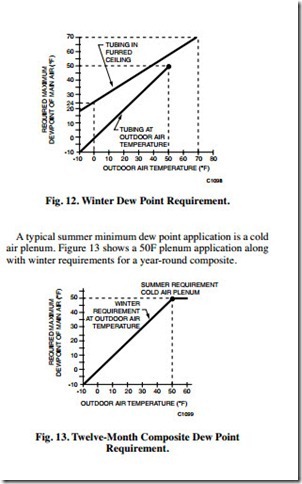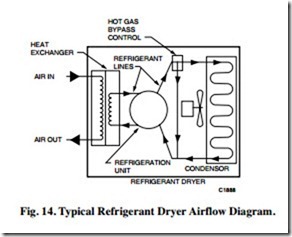AIR DRYING TECHNIQUES
GENERAL
Air should be dry enough to prevent condensation. Con- densation causes corrosion that can block orifices and valve mechanisms. In addition, dry air improves the ability of filters to remove oil and dirt.
Moisture in compressed air is removed by increasing pressure, decreasing temperature, or both. When air is compressed and cooled below its saturation point, moisture condenses. Draining the condensate from the storage tank causes some drying of the air supply, but an air dryer is often required.
An air dryer is selected according to the amount of moisture in the air and the lowest temperature to which an air line will be exposed. For a chart showing temperature and moisture content relationships at various air pressures, refer to the General Engineering Data section.
DRY AIR REQUIREMENT
The coldest ambient temperature to which tubing is exposed is the criterion for required dryness, or dew point. Dew point is the temperature at which moisture starts to condense out of the air.
The coldest winter exposure is normally a function of outdoor air temperature. Summer exposure is normally a function of temperature in cold air ducts or air conditioned space. The typical coldest winter application is an air line and control device (e.g., damper actuator) mounted on a rooftop air handling unit and exposed to outdoor air temperatures (Fig. 12). The second coldest winter exposure is an air line run in a furred ceiling or outside wall.
CONDENSING DRYING
The two methods of condensing drying are high-pressure drying and refrigerant drying.
High-Pressure Drying
High-pressure drying may be used when main air piping is kept away from outside walls and chilling equipment. During compression and cooling to ambient temperatures, air gives up moisture which then collects in the bottom of the storage tank. The higher the tank pressure, the greater the amount of moisture that condenses. Maintaining a high pressure removes the maximum amount of moisture. The compressor should have a higher operating pressure than is required for air supply purposes only. However, higher air pressure requires more energy to run the compressor. The tank must include a manual drain valve or an automatic trap to continually drain off accumulated moisture. With tank pressures of 70 to 90 psi, a dew point of approximately 70F at 20 psi can be obtained.
Refrigerant Drying
Lowering air temperature reduces the ability of air to hold water. The refrigerated dryer (Fig. 14) is the most common means of obtaining dry, compressed air and is available in several capacities. It provides the greatest system reliability and requires minimal maintenance.
The refrigerant dryer uses a non cycling operation with a hot gas bypass control on the refrigerant flow to provide a constant dew point of approximately 35F at the tank pressure.
The refrigeration circuit is hermetically sealed to prevent loss of refrigerant and lubricant and to protect against dirt.
The heat exchanger reduces the temperature of the com- pressed air passing through it. A separator/filter condenses both water and oil from the air and ejects the condensate through a drain. A temperature-sensing element controls the operation of the refrigeration system to maintain the tempera- ture in the exchanger.
With a dew point of 35F and an average compressor tank pressure of 80 psi, air is dried to a dew point of 12F at 20 psi. Under severe winter conditions and where piping and devices are exposed to outside temperatures, the 12F dew point may not be low enough.

